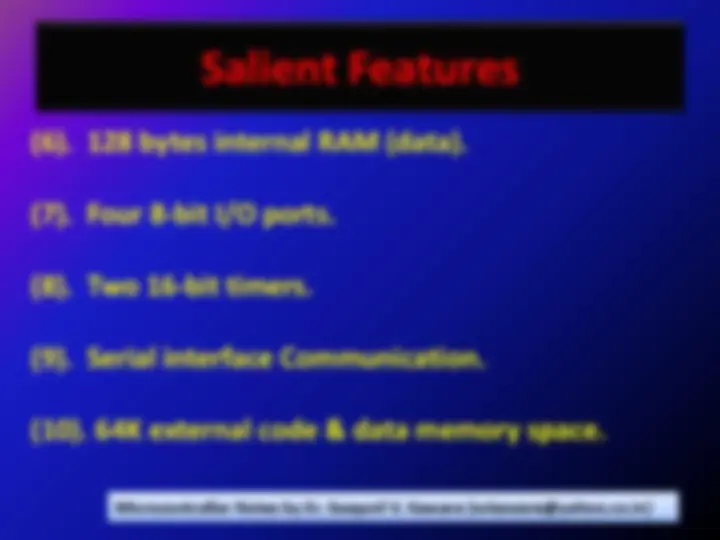

































Study with the several resources on Docsity

Earn points by helping other students or get them with a premium plan


Prepare for your exams
Study with the several resources on Docsity

Earn points to download
Earn points by helping other students or get them with a premium plan
Community
Ask the community for help and clear up your study doubts
Discover the best universities in your country according to Docsity users
Free resources
Download our free guides on studying techniques, anxiety management strategies, and thesis advice from Docsity tutors
8051 Microcontroller Architecture By Er. Swapnil V. Kaware
Typology: Lecture notes
1 / 39

This page cannot be seen from the preview
Don't miss anything!
































Microcontroller Notes by Er. Swapnil V. Kaware (svkaware@yahoo.co.in)
2 Microcontroller Notes by Er. Swapnil V. Kaware (svkaware@yahoo.co.in)
(6). 128 bytes internal RAM (data). (7). Four 8-bit I/O ports. (8). Two 16-bit timers. (9). Serial interface Communication. (10). 64K external code & data memory space. 4 Salient Features Microcontroller Notes by Er. Swapnil V. Kaware (svkaware@yahoo.co.in)
5 Salient Features
8051 Block Diagram 7
Internal Architecture
8 Microcontroller Notes by Er. Swapnil V. Kaware (svkaware@yahoo.co.in)
Internal Memory
10 Microcontroller Notes by Er. Swapnil V. Kaware (svkaware@yahoo.co.in)
11 Internal Memory Microcontroller Notes by Er. Swapnil V. Kaware (svkaware@yahoo.co.in)
13 Register banks in the 8051 Microcontroller
Special Function Registers
14
B Register (1). B register or accumulator B is used along with the accumulator for multiply and divide operations. (2). MUL AB: multiplies 8 bit unsigned values in A and B. and leaves the 16 bit result in A (low byte) and B (high byte). (3). DIV AB: divided A by B, leaving the integer result in A and remainder in B. (4). B register is bit-addressable. 16 Microcontroller Notes by Er. Swapnil V. Kaware (svkaware@yahoo.co.in)
17 PSW (Program Status word) / Flag Register
19 Stack Pointer Microcontroller Notes by Er. Swapnil V. Kaware (svkaware@yahoo.co.in)
Data pointer (DPTR) (1). Data pointer (DPTR): is used to access external data or code. (2). DPTR is a 16 bit register at addresses 82H (low byte) and 83H (high byte). (3). The data pointer is used in operations regarding external RAM and some instructions involving code memory. (4). Example: the following instructions write 55H into external RAM location 1000H: